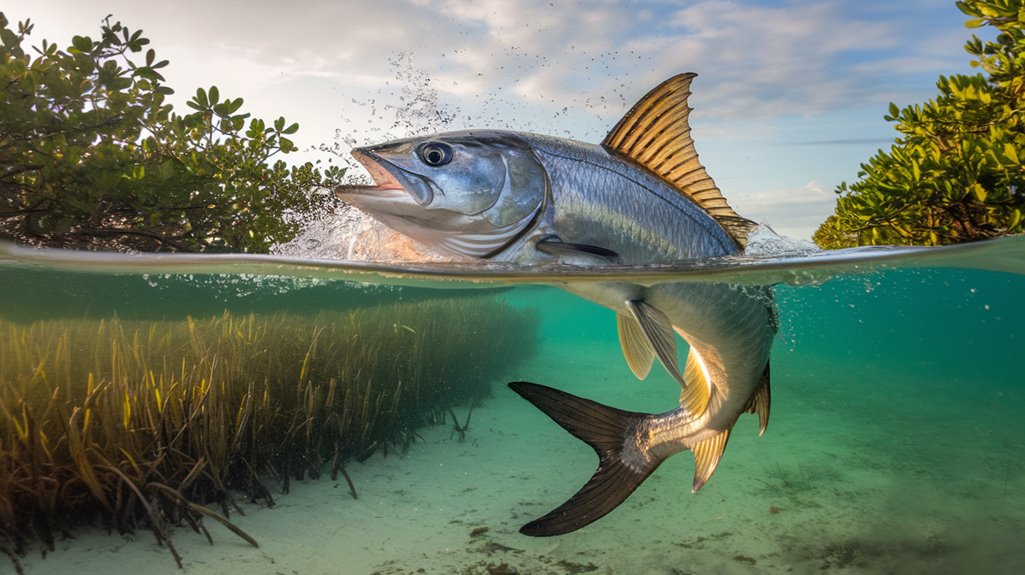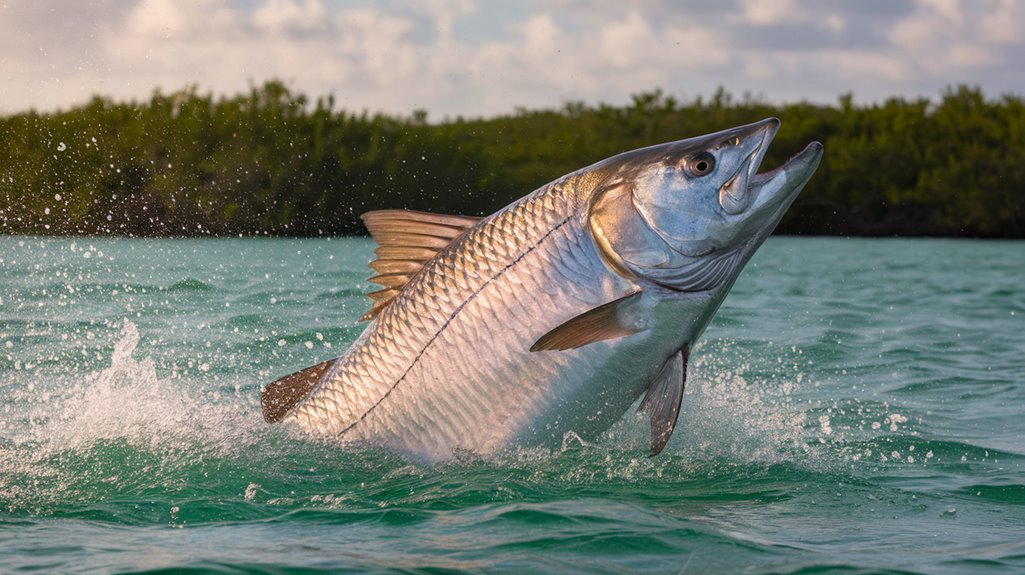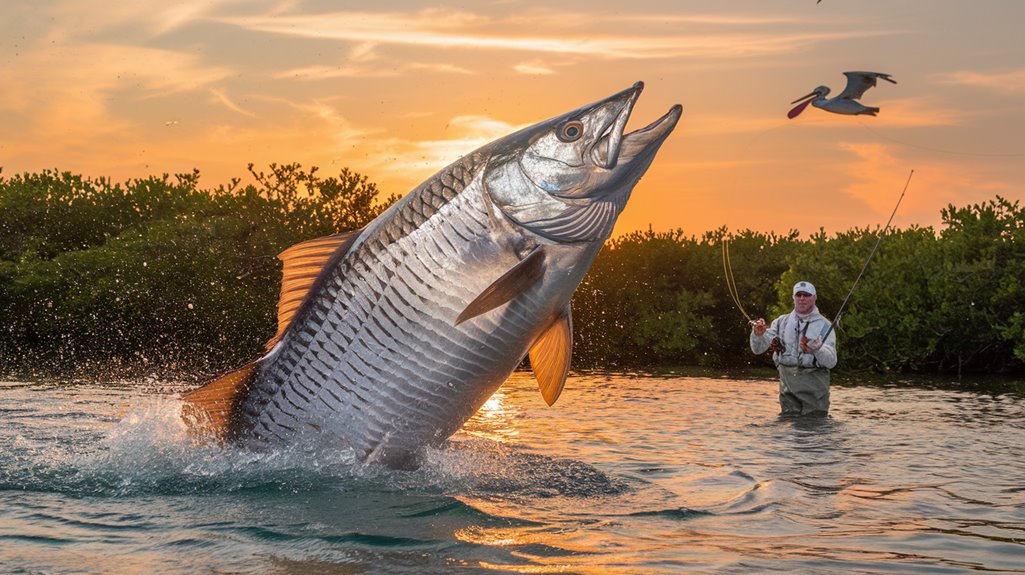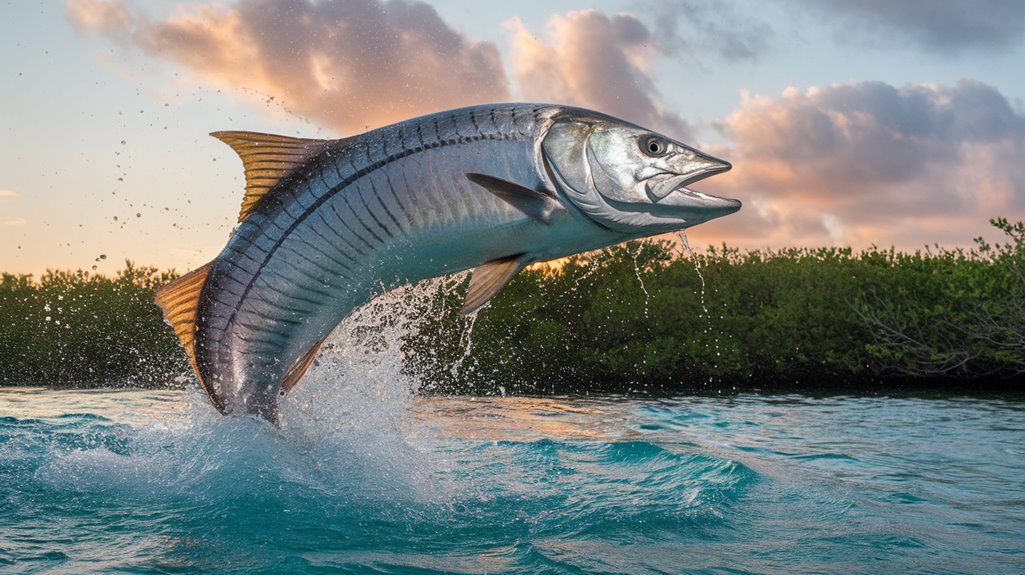You’ll find few sportfish that command the respect of Florida’s giant tarpon. When you’re standing on the bow at dawn, scanning the emerald waters of Boca Grande Pass, these hundred-pound titans roll and flash their silver sides like living mercury. They’ve drawn anglers to these waters for generations, testing gear and resolve with gill-rattling jumps and blistering runs. But landing your first tarpon isn’t just about the right tackle or timing – it’s about understanding their world.
- Key Takeaways
- The Silver King's Domain: Understanding Florida's Prime Tarpon Waters
- Mastering Essential Tackle and Techniques
- Peak Seasons and Migration Patterns
- Battle Tactics: From Hook-Set to Landing
- Conservation and Ethical Angling Practices
- Historic Catches and Record-Breaking Moments
- Frequently Asked Questions
- Conclusion
Key Takeaways
- Florida’s giant tarpon migrate along coastal waters from April through September, creating prime fishing opportunities in the Keys and Boca Grande Pass.
- These legendary gamefish can exceed 200 pounds and are known for spectacular aerial displays during battles with anglers.
- Successful tarpon pursuit requires specialized tackle including 10-12 weight fly rods and 80-100 pound leaders for challenging fights.
- The species inhabits diverse environments from deep offshore waters during spawning to brackish estuaries where juveniles develop.
- Modern tarpon fishing emphasizes conservation through catch-and-release practices, circle hooks, and proper handling techniques.
The Silver King’s Domain: Understanding Florida’s Prime Tarpon Waters

Giants of the shallows, Florida’s tarpon command the coastal waters from the Gulf of Mexico to the Atlantic seaboard. You’ll find these magnificent Silver Kings prowling the crystal-clear flats of the Florida Keys, rolling in Homosassa’s pristine waters, and cruising through countless estuaries along both coasts.
During peak season, from April through September, you’re in prime position to encounter these prehistoric warriors in their natural habitat. Whether you’re pursuing them with saltwater fly fishing gear or conventional tackle, you’ll discover tarpon gathering in predictable patterns around tidal flows and seasonal migrations. But remember, conservation comes first – these magnificent fish face mounting environmental pressures, so proper catch and release practices are essential to preserving the species for future generations.
Mastering Essential Tackle and Techniques
Successfully targeting Florida’s giant tarpon demands precision in both tackle selection and technique mastery. You’ll need to arm yourself with the right tackle setup, including live bait like mullet or crabs, and specialized lures designed for these massive fighters. For fly rod enthusiasts, a 10-12 weight setup paired with robust lines will give you the backbone needed for those explosive battles.
Your leader test should run between 80-100 pounds with a shock tippet – there’s no room for compromise when dealing with fish that can top 300 pounds. Focus on honing your casting accuracy, as you’ll often need to place your presentation in precise locations where tarpon gather. Don’t forget to regularly inspect your gear; worn lines or dull hooks can cost you the fish of a lifetime.
Peak Seasons and Migration Patterns

When warm spring currents sweep northward along Florida’s coast, they trigger one of nature’s most spectacular fishing events – the annual tarpon migration. You’ll find these silver kings moving from offshore waters into coastal lagoons and inlets, with peak activity hitting between April and September.
During full moons, you’ll want to target deeper offshore waters where giant tarpon gather in impressive numbers for spawning. Your best shots at hooking these magnificent fighters come in renowned hotspots like the Florida Keys, Boca Grande Pass, and Tampa Bay, where they’re drawn to schools of mullet and crabs. Watch for juvenile tarpon in brackish estuaries and bays, where they develop before joining the adult population’s seasonal movements. Timing your fishing trips around these migration patterns will greatly boost your chances of success.
Battle Tactics: From Hook-Set to Landing
Mastering the art of tarpon fishing starts with a perfect hook-set – that crucial moment between feeling the strike and securing your catch. When you feel the bite, respond with a swift, powerful upward motion to drive the hook through their tough, bony mouth.
Once you’re connected, you’ll need to adapt quickly to their acrobatic displays. As your tarpon launches skyward, keep that line tight and maintain steady pressure. You’ll want to adjust your drag settings on the fly to handle those blistering runs without breaking off.
Don’t rush the landing process. Let the fish tire itself out through its jumps and powerful surges. When you’ve finally worn down your silver king, keep it in the water while landing. These techniques will greatly boost your success rate and protect these magnificent gamefish.
Conservation and Ethical Angling Practices

You’ll find modern tarpon fishing has evolved beyond the trophy chase into a conservation-minded pursuit, where proper catch-and-release techniques can mean life or death for these ancient fish. Your commitment to ethical practices, including using circle hooks and minimizing fight times, helps protect Florida’s tarpon population for future generations. When you support habitat protection initiatives and practice sustainable fishing methods, you’re joining a crucial movement to preserve these magnificent gamefish and their essential nursery grounds.
Catch And Release Practices
Conservation pioneers and ethical anglers have revolutionized tarpon fishing through catch and release practices, creating a vital lifeline for these majestic gamefish. You’ll find that today’s ethical angling practices focus on keeping these ancient fish in the water during release, minimizing handling time, and using barbless hooks to boost survival rates.
The International Game Fish Association’s shift toward catch and release record-keeping has transformed how you’ll approach trophy fishing. Instead of harvesting these slow-growing giants, you’re now part of a conservation movement that’s helping protect tarpon populations for future generations. You’ll need to master proper release techniques, as these fish can live over 50 years when handled correctly. Remember, every tarpon you release today contributes to maintaining this iconic species’ presence in our waters tomorrow.
Habitat Protection Initiatives
While tarpon rely heavily on pristine coastal waters for their survival, dedicated habitat protection initiatives have become the cornerstone of Florida’s marine conservation strategy. You’ll find organizations working tirelessly to preserve crucial estuaries where juvenile tarpon develop and mature fish spawn. These conservation efforts go hand-in-hand with ethical angling practices, including proper catch and release techniques that minimize stress on these magnificent creatures.
As you navigate Florida’s coastal waters, you’ll notice the push for improved water quality through restoration projects and pollution control measures. These initiatives protect the delicate balance of marine ecosystems where tarpon thrive. By supporting habitat protection and following responsible fishing guidelines, you’re helping guarantee these silver kings continue to rule Florida’s waters for generations to come.
Sustainable Fishing Methods
Modern anglers have embraced sustainable fishing methods that prioritize the long-term survival of Florida’s giant tarpon. As a responsible tarpon angler, you’ll want to adopt catch-and-release practices that protect these magnificent gamefish while still experiencing the thrill of the battle.
- Use barbless hooks to minimize tissue damage and enable quick releases
- Practice proper handling techniques, keeping the fish in the water whenever possible
- Document your catch with measurements rather than harvesting for records
Conservation efforts have transformed how we approach tarpon fishing. The IGFA’s shift toward catch-and-release record-keeping reflects the growing commitment to ethical angling practices. You’ll find that by staying current with local regulations and participating in habitat protection programs, you’re contributing to the preservation of this legendary species for future generations.
Historic Catches and Record-Breaking Moments
Throughout Florida’s rich angling history, giant tarpon have captured the imagination of saltwater enthusiasts with their spectacular size and strength. You’ll find the most impressive historic catches in the crystalline waters off Homosassa, where the verified world record of 286 pounds still stands, though a potential 326-pounder surfaced in 2017. Among the best tarpon anglers, Billy Pate’s remarkable achievement of landing over 4,000 silver kings showcases the endless pursuit of these magnificent gamefish.
| Era | Achievement | Conservation Impact |
|---|---|---|
| 1950s | First 200lb+ on Fly | Catch Documentation |
| 1975 | Pate’s World Record | Release Practices |
| 1990s | Release Only Tournaments | Population Studies |
| 2000s | Circle Hook Movement | Mortality Reduction |
Today’s fly fishing for tarpon emphasizes conservation, marking a shift from record-chasing to sustainable practices that guarantee these magnificent fish thrive for future generations.
Frequently Asked Questions
Why Is It Illegal to Catch Tarpon in Florida?
You can’t keep tarpon in Florida because they’re protected by catch-and-release laws to conserve their population. These magnificent gamefish are valuable for both ecology and recreational angling’s future.
What Is the Biggest Tarpon Ever Caught in Florida?
You’re looking at a massive 286-pounder as Florida’s official record tarpon, certified by IGFA, though there’s buzz about an unverified 326-pound silver king caught in 2017.
How Old Is a 100 Pound Tarpon?
You’re looking at a tarpon that’s weathered 10 to 15 seasons in the brine. These silver kings pack on weight differently depending on their feeding grounds and local conditions they’ve encountered.
What’s so Special About Tarpon?
You’ll find tarpon are prehistoric beasts that can gulp air, leap like missiles, and live over 50 years. They’re built like silver tanks, fight harder than anything, and’ll test your angling skills.
Conclusion
You’ve now joined the ranks of those who chase Florida’s silver kings. Whether you’re scanning Boca Grande’s tide lines at dawn or working the Keys’ channels, you’re part of a timeless pursuit. Remember, it’s not just about the catch – it’s about preserving these magnificent fighters for tomorrow’s anglers. Keep your eyes on the rolling fish, your drag checked, and your conservation ethics sharp.

